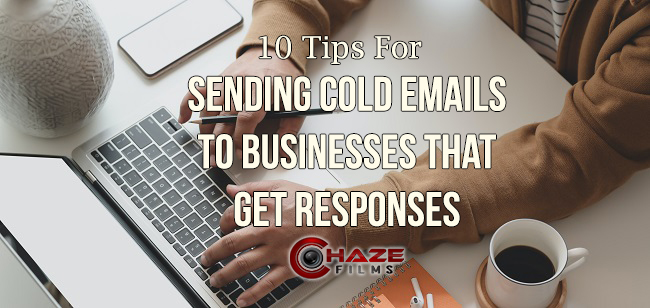
 Are there businesses or clients that you would love to offer your service or business to but you don’t know what to say when sending them an email? Your initial “cold” email to a business or potential client you’ve never talked to will determine if they actually take the time to read it and respond versus them deleting it almost instantly.
Are there businesses or clients that you would love to offer your service or business to but you don’t know what to say when sending them an email? Your initial “cold” email to a business or potential client you’ve never talked to will determine if they actually take the time to read it and respond versus them deleting it almost instantly.
If you don’t know what to say, let us help you out with that! Here are out 10 tips for sending cold emails to businesses you want to work with! But first…
What Are Cold Emails?
There are different definitions of what a “cold email” is, but in essence, it’s an email sent to a potential client that you have had no prior relationship or contact with before.
Whether you’re in a business for yourself or just starting out, you’ve probably received some sort of cold email at some point. Often times, they are totally spammy, impersonal and gets deleted before you make it to the second sentence.
Please do not send those types of emails.
I often get these types of emails – whether they’re trying to offer me an outsourcing video editor service or wanting me to sign up for something – there have been times where I actually take the time to respond to them and let them what they could do to improve rather than send the same email to everyone. I mean, you want to turn a cold email to a warm lead, which is the point. But even if I respond to them, they already lost me.
With that said, here are our tips from our experiences on how to send cold emails or messages to business:
1. Research the business you’re contacting
 If you’re reaching out to a business, at the very least, you should know what they do and what you can offer to help them. That should be a given but you should go in even more detail when you’re researching.
If you’re reaching out to a business, at the very least, you should know what they do and what you can offer to help them. That should be a given but you should go in even more detail when you’re researching.
Let me give you some examples…
Say you’re contacting a business as a videographer and you notice they don’t have any videos to help market themselves on any of their social media or even their website. That’s where you would come in and offer exactly what they don’t know they need yet.
But look a little deeper. For instance, if you notice that none of their social media accounts have been updated in the past year, that probably means they’re not really focusing on social media so you can even offer that service or focus on how you can help outside of it (sponsored ads, video for their website or landing page, etc).
2. Focus on them, NOT yourself
One of the mistakes I made early on was not focusing enough on the potential client. You have to explain and educate how you can help them while taking away the focus on what you’re gaining out of it.
It shouldn’t be why they need you but rather how you can help their needs.
How can whatever you offer them help their business? Why should they take this specific action? Focus on that first so you can get a response back and ideally, setting up a phone call or in-person meeting to discuss in more details.
3. Personalize your message to someone specific
Now let’s get into the emails. One of the first signs you’re just copying and pasting the same message to everyone is how you address them. Did you not take a couple of minutes to at least check out their social media or their About Us page on their website to get their name so you know who you’re actually contacting?
What’s even worse is when people just automate who they’re addressing things to by using your social tag such as “Dear @chazefilms” or something as generic as “to whom it may concern”.
If you want to seem less spammy, take a few minutes to do step 1 and do research on your potential next client’s name, at the very least. Think about it like this, if you actually address them directly, you already caught their attention because they’re probably thinking “wait, how did they know my name?” or “wait, do I know this person?!”
4. Who are YOU – Introduce yourself
 You’ve done your research on them, now introduce yourself so they can do their research on you, if they wanted. Make sure you have a website, social media and other places where they can find more information about you because after all, you are a stranger to them so they’ll probably want to do some research on you as well.
You’ve done your research on them, now introduce yourself so they can do their research on you, if they wanted. Make sure you have a website, social media and other places where they can find more information about you because after all, you are a stranger to them so they’ll probably want to do some research on you as well.
Supply them with enough information for that so they’ll feel comfortable moving forward with you after looking you up.
If you have some sort of mutual connection or anything, make sure you mention that so they don’t feel like you’re a complete stranger but a friend of a friend.
5. Compliments are good
Do they have a great product or service? Maybe they have amazing photos on their social media? Whatever it is, make sure you compliment them on it. It can be something simple and subtle so it doesn’t feel as though it’s over the top and you’re just trying to kiss their ass.
Don’t get me wrong, you want to but without them feeling like you are. I mean, who doesn’t like compliments? And if you’ve done your research, this should come pretty easy.
6. Be clear on how you can help their business
Don’t beat around the bush, you have to be clear on how you can actually help their business. Are you helping them create new fresh content for social media? Will your services help them gain more customers? How will you directly help their business?
Whichever way you can help them, be clear about it so they know exactly what they’ll be getting from you and how it will their business. And if you have lots to offer, just focus on one that you think is their biggest need for now. The goal is to turn them into a repeat client so one task at a time.
7. Show proof of your expertise
 Did you help another business grow? Did you help them create such an amazing video that they received lots of exposure or new customers from it? Show them this proof.
Did you help another business grow? Did you help them create such an amazing video that they received lots of exposure or new customers from it? Show them this proof.
If you made an amazing video that helped a previous client, link to that specific video so people can see how well it was received and how it performed. If you helped their social media grow, show them some before and after statistics. If you have clients that wrote you testimonials on your services, link to them.
All of this will help backup your claim on how you can actually help because it emphasizes the proof of your expertise.
8. Catchy, short subject line
This should be higher on the list but since there wasn’t a specific order of priority, well, here it is. There are different ways of adding a catchy subject line but it really depends on the type of client you’re trying to attract.
For instance, contacting a small business versus realtor versus corporate will probably all be slightly different. But in any case, we would recommend keeping it short (under 50 characters), address what the email is about in a catchy way and try to include how you can help them.
For instance, “Lets help you attract more clients through video”. Short, to the point and it addresses what the email will be about while catching their attention on how you can help their business.
9. Call-to-action
The goal with sending cold emails is to get them to do a call-to-action, a.k.a. respond. But you don’t want to go back and forth with emails all day because potential clients want to be able to talk to someone.
Offer to discuss more details on the phone. A majority of the time when I’ve scheduled a phone call with a potential client, I’m able to lock them in just by being genuine on wanting to help their business.
10. Show appreciation
Remember, we’re taking up their valuable time so showing some appreciation to them goes a long way. It doesn’t have to be anything over-the-top but something more than “thanks!”.
For instance, “I appreciate your time and look forward to hearing from you!” Short, simple and shows appreciation for them even reading your cold email.
Conclusion
There is no perfect way of sending a cold email and often times, you have to adjust and test as you go to see what works for you but following these tips listed above has helped me get responses as well as turn them into paid clients and I believe it’ll help you too!
I’ll have email templates available for our newsletter subscribers so make sure you subscribe if that interest you!